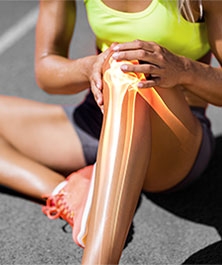
Why Physical Therapy?
Many patients ask me why they need physical therapy (PT) after their knee replacement. A proper response to this leads us to the effect that surgery has on the knee joint. When a joint is treated surgically, there is an initial injury to the joint which is a small price to pay for the ultimate benefits of the surgery. The surgery can cause some patients to feel restricted in their movement and not want to bend their knee. Additionally, knee replacement can lead to swelling buildup in the joint. The combination of these factors can lead to stiffness or the inability to bend the knee in the after math of a knee replacement. The stiffness is combined with post-surgical pain, making it difficult for patients to get out of bed and move around the house. Physical therapy is an incredibly important part of the post-knee replacement process.
Prior to Surgery
Another misconception is that PT must start after surgery. In fact, in many cases, we order PT for patients prior to their surgery. We term this "Prehab." This PT is important for getting the muscles as strong as possible prior to the surgery in order to make the recovery after surgery easier. When we do outpatient knee replacement, we will arrange for the physical therapists to come to the patient's home. This is arranged through a type of agency called a "home health" agency. These agencies have nurses and physical therapists who can assist patients at home until they are strong enough to leave the house after their surgery. The pre-surgery visits by physical therapists confirm that the home is set up properly for the patient upon their return from surgery. This includes making sure that the bed is close to the bathroom, that there are not a lot of loose rugs and other objects laying around the house, and that there are not too many steps or other obstacles that will make it difficult for the patient after their surgery. The therapist will also introduce the patient to assistive devices they may need during recuperation. It is crucial that patients know what to expect and can prepare themselves and their homes for the recovery period.
In the Surgery Center or Hospital
Physical therapy starts while the patient is still in the surgery center or in the hospital. The keys here are to be sure the patient has good balance and good strength to be able to move around. Immediately after the surgery, patients have a nerve block that numbs their leg without affecting the strength of the muscles. The goal of the PT at that point is to be sure they are using their other leg appropriately and can get on and off a chair and can use a walker appropriately.
Types of Exercises
The physical therapist tailors the range of motion, muscle strengthening and balance exercises to the patient’s needs. If the patient has specific activity issues that need work, such as occupational requirements or certain home requirements, this is also addressed.
The therapist monitors each patient's progress and adds activities as the patient accomplishes them.
Pain Management
Physical therapy can help patients manage pain by keeping the joint moving, by supervising cold therapy and through the release of endorphins (our own internal pain relievers). This lessens the need for opioids and other medications. Exercise can boost your mood after surgery, minimizing any surgical discomfort and anxiety.
Proper Healing
Physical therapists are an important member of the team that partners with your surgeon in recognizing any issues with your progress after surgery, including slower than expected rehabilitation and any issues related to the surgical wound.
That Extra Support
Some patients can do a lot of their own exercises religiously. However, based on our experience, most patients benefit greatly by physical therapy. Most patients love the extra support and "push" that only a physical therapist can provide.
A trained physical therapist knows what each patient can and cannot do safely. The therapist is there to prevent the patient from over doing exercises and potentially prolonging the recovery process.
Contact Us
If you would like more information about physical therapy after knee replacement surgery, contact the Joint Preservation Institute today to schedule your visit to our Sacramento or Walnut Creek office. Dr. Jamali will discuss the type of physical therapy involved after surgery and can recommend our trusted physical therapy professionals.




 The Importance of Physical Therapy After Knee Replacement
The Importance of Physical Therapy After Knee Replacement 








